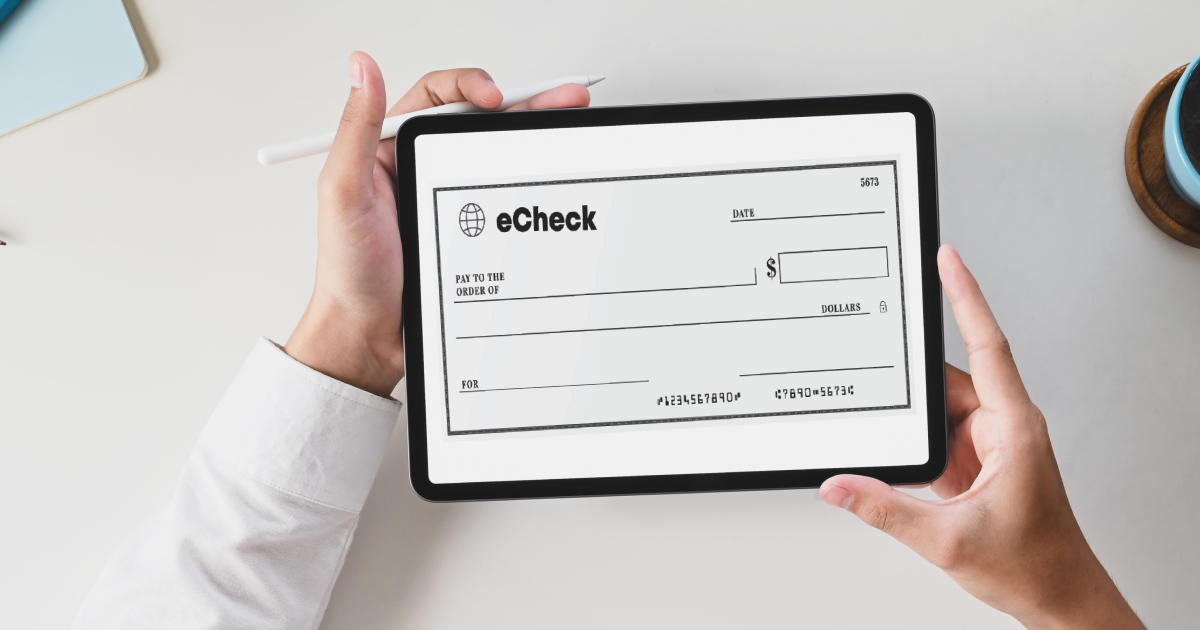
| December 13th, 2023 |
Effortless Transactions — Mastering eCheck Payment Processing for Business Success!
In the dynamic landscape of modern business, the quest for streamlined and secure payment processing is a perpetual pursuit. As technology continues to evolve, so do the options available to businesses seeking efficient and cost-effective transaction solutions. One such solution gaining popularity is eCheck payment processing. This comprehensive guide will walk you through the nuances of setting up eCheck payments for your business, highlighting the benefits, implementation steps, and best practices to ensure a smooth and secure financial journey.
Understanding eChecks —
Before delving into the setup process, it’s essential to grasp the fundamentals of eChecks. An electronic check, or eCheck, is a digital version of a traditional paper check. Unlike credit card transactions, which involve complex networks and intermediaries, eChecks operate within the established ACH (Automated Clearing House) system. This process allows funds to move securely from one bank account to another, combining the familiarity of paper checks with the efficiency of electronic transactions.
Benefits of eCheck Payment Processing —
- Cost-Effective Transactions: eChecks often come with lower processing fees compared to credit card transactions, making them an attractive option for businesses looking to reduce operational costs.
- Increased Security: Leveraging secure ACH networks, eCheck transactions offer a heightened level of security. Encryption and authentication protocols ensure that sensitive financial information remains protected throughout the transfer.
- Efficiency and Convenience: With eChecks, the manual handling of paper checks becomes obsolete. The digital nature of eCheck payments accelerates the entire payment process, reducing delays and enhancing overall efficiency.
- Wider Customer Reach: By accommodating customers who prefer alternative payment methods, such as those without credit cards, businesses can expand their customer base and improve overall accessibility.
Setting Up eCheck Payment Processing —
1. Assessing Legal and Regulatory Compliance:
Before integrating eCheck payments, ensure compliance with relevant legal and regulatory requirements. Familiarize yourself with ACH rules and regulations, as well as any industry-specific guidelines that may apply to your business.
2. Choose a Reliable Payment Processor:
Selecting a reputable payment processor is crucial to the success of your eCheck payment system. Look for providers with a proven track record, robust security measures, and a user-friendly interface. Popular choices include Stripe, PayPal, and Square.
3. Verify Bank Account Information:
To facilitate eCheck transactions, accurate and up-to-date bank account information is paramount. Ensure that the provided details, such as account number and routing number, are error-free to prevent transaction failures.
4. Integrate eCheck into Your Payment Gateway:
Work closely with your chosen payment processor to seamlessly integrate eCheck functionality into your existing payment gateway. This step may involve API integration or the installation of specific plugins, depending on your platform.
5. Communicate with Your Bank:
Notify your bank about your intention to process eChecks. This proactive communication helps in avoiding potential issues and ensures a smoother integration into the ACH network.
6. Implement Robust Security Measures:
Prioritize the security of both your business and customer data. Implement encryption protocols, multi-factor authentication, and regular security audits to safeguard against potential cyber threats.
7. Test Transactions Thoroughly:
Conduct thorough testing of your eCheck payment system before making it live. This includes simulating various transaction scenarios to identify and resolve any potential glitches or issues.
8. Educate Your Team and Customers:
Ensure that your team is well-versed in the new eCheck payment system. Additionally, provide clear and concise instructions to your customers on how to make eCheck payments, addressing any concerns or questions they may have.
Best Practices for eCheck Payment Processing —
- Educate Customers: Create informative guides and FAQs to educate your customers on the benefits and processes involved in eCheck payments. Clear communication can encourage wider adoption.
- Offer Incentives: Encourage the adoption of eCheck payments by providing incentives such as discounts or exclusive offers for customers who choose this payment method.
- Regularly Update Security Protocols: Stay vigilant against evolving cybersecurity threats. Regularly update and reinforce security protocols to ensure the continued safety of sensitive financial information.
- Monitor and Analyze Transactions: Implement robust monitoring tools to keep track of eCheck transactions. Analyze transaction data to identify patterns, detect anomalies, and optimize your payment processing system.
- Provide Excellent Customer Support: Establish a responsive customer support system to address any issues or inquiries related to eCheck payments promptly. A positive customer experience is crucial for fostering trust in the new payment method.
Conclusion —
In the ever-evolving landscape of digital commerce, eCheck payment processing stands out as a reliable and efficient alternative. By understanding the fundamentals, following a systematic setup process, and adhering to best practices, businesses can unlock the benefits of eCheck transactions. As the demand for diverse payment options continues to rise, embracing eChecks positions your business at the forefront of innovation, offering customers a secure and convenient way to transact in the digital age.
